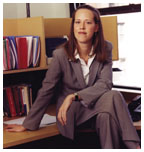Have an opinion about this issue of PAW? Please take a minute to click here and fill out our online survey. It’s an easy way to let the editors know what you like and dislike, and how you think PAW might do better. (All responses will be anonymous.) |
June 8, 2005: A moment with...
(Photo by Jean-Christian Bourcart) |
Wendy Kopp ’89
This year, more than 17,000 college seniors around the country applied for 2,000 jobs teaching in low-income public schools through Teach for America, the widely known program that began as Wendy Kopp ’89’s senior thesis. Over the years, Teach for America has placed more than 12,000 teachers in public classrooms, and the program is now recognized by school districts as a vital source of teachers in needy urban and rural schools. Kopp, who is president of the organization, recently spoke to PAW’s Mark F. Bernstein ’83.
Some have called Teach for America the Peace Corps of this generation. What do you think of that?
Part of my initial conception of Teach for America was that it would be for our generation what the Peace Corps was for an earlier generation — though of course the Peace Corps does still thrive today as well.
Is it true that the program is very popular among Ivy League students?
It is. Twelve percent of the senior class at Yale applied to Teach for America this year, plus 11 percent at Dartmouth and 8 percent at Princeton and Harvard. We do very well at other schools, too: 12 percent at Spelman, for example, and 11 percent at Amherst. We put tremendous energy into the top schools. I think we do well at the Ivies because there are so many students at these schools who consider themselves leaders, who have a sense of service, and who have the confidence to take the road less traveled.
Isn’t it difficult to get many Ivy League graduates to enter teaching as a lifelong commitment at today’s generally low salaries?
In fact, we see a number of our corps members make long-term commitments to teaching — Jason Kamras ’95, for example, who was just named the 2005 National Teacher of the Year, is currently in his eighth year teaching in the same school in which he was placed in Washington, D.C. [See article on page 10.] About 30 percent of our corps members are still teaching after 10 years, and many more assume other positions in the field, such as school principalships and district leadership posts. All this said, there’s a lot we could do to keep talented people in teaching longer. Implementing career ladders so that experienced teachers can assume greater responsibility and make higher salaries without leaving the classroom is one important step.
What have you learned about public education in America?
Each day we see unconscionable disparities. The fact that 9-year-olds who happen to be born in our poorest communities are already three grade levels behind 9-year-olds who happen to be born in our wealthiest communities is outrageous in a country that aspires so admirably to be a land of opportunity. The thing that fuels us is to see those disparities juxtaposed against the possibilities, because we see constantly that when kids in low-income communities are given the opportunities they deserve, they can and do excel. It’s not that the kids don’t have the same potential and hopes and dreams and capacities for success — and that fuels our sense of responsibility to take this movement to a higher level.
Is there a Teach for America philosophy of teaching?
We have found that there’s no one instructional strategy, though there are certain things that successful teachers in low-income communities do. They build strong cultures of achievement in their classrooms that foster not only good behavior but also high levels of academic performance. And they teach in a very goal-oriented, standards-based way.
Can anyone teach?
I don’t think so, no. What we have learned is that in the most under-resourced parts of the country, being an effective teacher is like being an effective leader in any other context. It takes people who set a vision of where they want their kids to be at the end of the year and then mobilize others — the kids, their parents, other allies within the school — to work with them.
Have you ever taught?
I haven’t. I’ve been running this since I graduated.
How important is it to persuade more participants to remain in education after their two-year commitment is over?
What we’re trying to do is build a movement to eliminate educational
inequality by enlisting our country’s most promising future leaders
in the effort. So, on the one hand, we’re trying to provide kids
growing up today with another source of teachers who will push beyond
expectations to advance their achievement. At the same time, we’re
working to influence those future leaders. We know that the experience
of teaching in low-income communities will give them rare insights and
added conviction that will fuel a lifetime of leadership for change. ![]()


